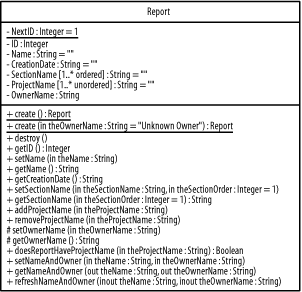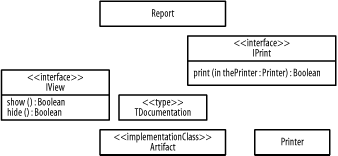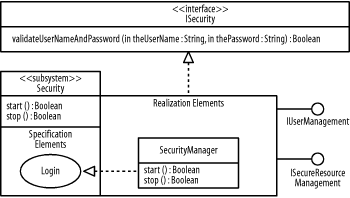3.6 Exercises
Solutions to these exercises are supplied in Section B.1.1
Describe Figure 3-44: identify the class and
describe its attributes and operations.
 Describe Figure 3-45: identify the object and
describe its attribute values.
 Describe Figure 3-46: identify the classes and their
associations.

Update the diagram stepwise to show the following details. After each
step, check your answers against the solutions shown in Appendix B:
When a worker has a skill, the years of experience is maintained for
the relationship. A worker may have another worker as a manager, and a worker who is a
manager must manage five or more workers. Given a manager, you can
determine whom she manages, but given a worker, you are unable to
determine who his manager is. An activity may have no more than one previous activity and any
number of next activities. Using these rolenames, we can show how
activities are ordered. Given an activity, you can only determine its
next activities (if it has any) but not its previous activity (it if
has one). This is similar to how a team may be made of subteams in
that you have to have a team before you can have a subteam. A worker is not simply associated with a set of skills, but a worker
has skills. Specifically, a worker must have three or more skills,
and any number of workers may have the same skill. A project is not simply associated with a set of activities, but a
project contains activities. Specifically, a project must have one or
more activities, and an activity must belong only to one project. Projects and activities are specific types of work. Describe Figure 3-47: identify the classes and their
associations.

Update the diagram stepwise (check your answers after each step in
Appendix B):
A plan pertains to a single project and involves one or more workers
and one or more activities. A worker may have zero or more plans, and a plan must belong to a
single worker. Each plan contains a single schedule. Given a plan, you can determine
its schedule, but given a schedule, you are unable to determine the
plan to which it pertains. When an activity is on a schedule, it is called a scheduled activity,
and the start date, end date, and duration are maintained for the
scheduled activity. Each schedule may have zero or more activities,
but an activity must be associated with a single schedule. A milestone, a major point in project, is a special type of scheduled
activity where it has zero or more work products that have a specific
status. A milestone has any number of work products associated with
it, and a work product may be related to any number of milestones. Given the solutions to questions 3 and 4, create a diagram to
communicate the following:
Nora manages Andy and Jonathan, who are all workers. You are
interested in the following skills: project management, requirements
gathering, analysis, design, implementation, testing, deployment,
Extensible Markup Language (XML), Structured Query Language (SQL),
Java, C#, and C++. Nora has 10 years of project management skills, 5
years of analysis skills, and 3 years of design skills. Andy has 3
years of experience in each of the following skills: XML, SQL, Java,
and C#. Jonathan has 10 years of experience in SQL, 5 years of
experience in C++, 2 years of experience in Java, and 6 months of
experience in C#. A project named Eagle contains the following activities: requirements
gathering, analysis, design, implementation, testing, and deployment.
The requirements gathering activity is associated with the analysis
activity where the requirements gathering activity plays the role of
the previous activity and the analysis activity plays the role of the
next activity. The analysis activity is associated with the design
activity where the analysis activity plays the role of the previous
activity and the design activity plays the role of the next activity.
The design activity is associated with the implementation activity
where the design activity plays the role of the previous activity and
the implementation activity plays the role of the next activity. The
design activity is associated with the implementation activity where
the design activity plays the role of the previous activity and the
implementation activity plays the role of the next activity. The
implementation activity is associated with the testing activity where
the implementation activity plays the role of the previous activity
and the testing activity plays the role of the next activity. The
testing activity is associated with the deployment activity where the
testing activity plays the role of the previous activity and the
deployment activity plays the role of the next activity. Nora and Phillip, who are workers, are on a project named Hawk. This
project involves acquisition activities followed by implementation
activities. Nora has 10 years of acquisition skills and 5 years of
implementation skills. Phillip has 5 years of implementation skills.
Nora and Phillip are associated with those activities that correspond
to their skills. The project also has a plan, and Nora is the manager
for the project. Describe Figure 3-48: identify types, interfaces,
undifferentiated classes, and implementation classes; and describe
their attributes and operations. Update the diagram to reflect that a
report is a type of documentation that may be viewed or printed, and
is actually implemented as an artifact.
 Describe Figure 3-49: identify the subsystem and
describe its specification elements and realization elements.
 Using Figure 3-48, create a diagram to communicate
that the undifferentiated classes and implementation classes make up
a reporting subsystem that provides the view and print interfaces,
and that the Printer class that is used by the
print interface is located inside a printing package.
|